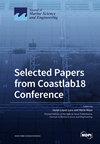Optimizing Multi-Quay Combined Berth and Quay Crane Allocation Using Computational Intelligence
IF 2.8
3区 地球科学
Q1 ENGINEERING, MARINE
引用次数: 0
Abstract
The significant increase in international seaborne trade volumes over the last several years is pushing port operators to improve the efficiency of terminal processes and reduce vessel turnaround time. Toward this direction, this study investigates and solves the combined berth allocation problem (BAP) and quay crane allocation problem (QCAP) in a multi-quay (MQ) setting using computational intelligence (CI) approaches. First, the study develops a mathematical model representing a real port environment and then adapts the cuckoo search algorithm (CSA) for the first time in this setup. The CSA is inspired by nature by following the basic rules of breeding parasitism of some cuckoo species that lay eggs in other birds’ nests. For comparison purposes, we implement two baseline approaches, first come first serve and exact MILP, and two CI approaches, particle swarm optimization (PSO) and genetic algorithm (GA), that are typically used to solve such complex or NP-hard problems. Performance assessment is carried out via a comprehensive series of experiments using real-world data. Experimental findings show that the MILP method can address the problems only when a small dataset is employed. In contrast, the newly adapted CSA can solve larger instances of MQ BAP and QCAP within significantly reduced computation times.利用计算智能优化多码头组合泊位和码头起重机分配
过去几年来,国际海运贸易量大幅增长,推动港口运营商提高码头流程效率,缩短船舶周转时间。为此,本研究采用计算智能 (CI) 方法研究并解决了多码头 (MQ) 环境下的泊位分配问题 (BAP) 和码头起重机分配问题 (QCAP)。首先,该研究建立了一个代表真实港口环境的数学模型,然后首次在此设置中采用了布谷鸟搜索算法(CSA)。布谷鸟搜索算法的灵感来源于自然界,它遵循一些布谷鸟物种在其他鸟类巢中产卵的基本繁殖寄生规则。为了进行比较,我们采用了两种基准方法--先到先得和精确 MILP,以及两种 CI 方法--粒子群优化(PSO)和遗传算法(GA),这两种方法通常用于解决此类复杂或 NP-困难问题。性能评估是通过一系列使用真实世界数据的综合实验进行的。实验结果表明,MILP 方法只有在使用小数据集时才能解决问题。相比之下,新调整的 CSA 可以在显著缩短的计算时间内解决 MQ BAP 和 QCAP 的较大实例。
本文章由计算机程序翻译,如有差异,请以英文原文为准。
求助全文
约1分钟内获得全文
求助全文
来源期刊

Journal of Marine Science and Engineering
Engineering-Ocean Engineering
CiteScore
4.40
自引率
20.70%
发文量
1640
审稿时长
18.09 days
期刊介绍:
Journal of Marine Science and Engineering (JMSE; ISSN 2077-1312) is an international, peer-reviewed open access journal which provides an advanced forum for studies related to marine science and engineering. It publishes reviews, research papers and communications. Our aim is to encourage scientists to publish their experimental and theoretical results in as much detail as possible. There is no restriction on the length of the papers. The full experimental details must be provided so that the results can be reproduced. Electronic files and software regarding the full details of the calculation or experimental procedure, if unable to be published in a normal way, can be deposited as supplementary electronic material.
 求助内容:
求助内容: 应助结果提醒方式:
应助结果提醒方式:


